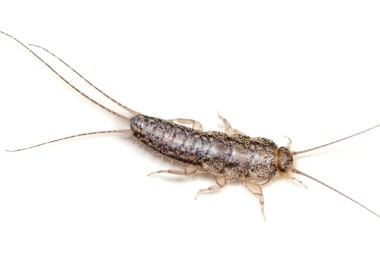
Silverfish are occasional invaders that often enter homes and other structures, often times accidentally, in order to find a high humidity environment to live in. Silverfish can be found invading homes and businesses throughout Missouri.
| Pest Identification | |
|---|---|
| Recognition | Silverfish are not a winged species of insect. Instead of moving from place to place by flying, they move in a very quick fish-like manner. Adult silverfish grow to be about ¾ of an inch in length and are silver to brown in color with a metallic appearance from the silvery-grayish scales that cover their bodies. Silverfish have a very distinctive tear-drop shaped body, a long pair of antennae, and 3 very long bristle-like appendages protruding from the back of their body. |
| Biology | After mating, adult females will lay their eggs in the cracks and crevices of floors, walls, and other suitable areas that are located near food sources. The eggs will then, after a period of time, (3 months to 3 years) hatch into nymphs. The nymphs appear to be smaller versions of the adults. The nymphs will molt several times until they reach sexual maturity and adulthood. Silverfish have a very long lifespan; in the right protected conditions, they can live between 6 and 8 years. |
| Habits | Silverfish are nocturnal creatures and during the day will hide in high humidity areas like basements, under sinks in kitchen and bathrooms, in crawl spaces, and in laundry rooms. Silverfish cannot survive without humidity. In the evening they will come out of their hiding spots to feed on foods like paper, glue, wallpaper, fabrics, other dead insects, and pantry items like flour, oats, and cereals. Silverfish are most often introduced into a home or other building in boxes or piles of paper that are already infested and that are brought inside. They will also enter homes through cracks and crevices found in foundations while foraging for food sources or a humid environment. Silverfish aren’t dangerous to people, but they are dangerous to personal belongings and food sources. They will contaminate pantry items, put holes in clothing, and damage pictures and wallpaper. Silverfish do not bite or sting and are not known to cause any significant health risks to people. |
| Prevention | Once silverfish are introduced into a home, they can be very difficult to get rid of. This is why preventing silverfish from getting into your home is so important. Silverfish prevention tips include: Seal cracks and crevices in your foundation; caulk gaps found around exterior windows and doors. Install door sweeps underneath all exterior doors. Inspect newspapers and boxes for signs of silverfish before bringing those items inside. Place dry goods in plastic or glass containers that have tight-fitting lids. Use dehumidifiers to reduce humidity levels within your home. |
| Professional | The most effective way to control silverfish is with the help of a professional pest control expert. At Rottler Lawn & Pest Solutions, a trained technician will inspect your home and find all the areas where silverfish are hiding and breeding. We will then provide pest control services that get rid of silverfish and offer suggestions on controlling and preventing future problems with silverfish. |

